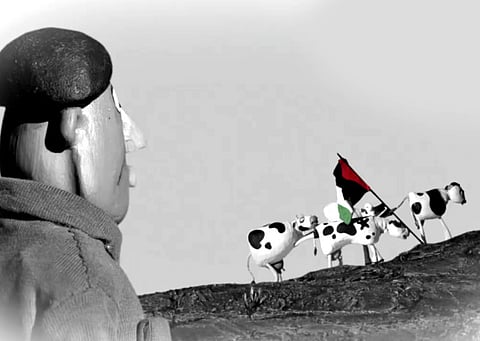ADFF: ‘The Wanted 18’ uses humour for grim tale
Documentary film is about one Palestinian town’s experience of the First Intifada

So rarely do we see a portrayal of what the intifada really meant, on an everyday basis, to the Palestinian people. Even more rarely do we see this told through 18 controversial cows.
The Wanted 18, a documentary film co-produced by Amer Shomali and Paul Cowan, gives a rare look at the tenacious, community-led resistance that took place during the First Intifada in the town of Beit Sahour, between 1987-1993. Through interviews, stop motion animations, illustrations and historical re-enactments, it highlights the everyday revolutionaries and intellectuals who came together under dehumanising occupation to reclaim their livelihood, by creating neighbourhood committees — agricultural, medical, educational, and so on — and forging a self-sustenance that allowed them to boycott Israeli products.
The film took five long years to make, and though they left Shomali fatigued, the finished product made him realise it wasn’t for nothing.
“We want the future generations to be able to return to something solid about this period in Palestine that is deliberately erased,” said Shomali ahead of the film’s Abu Dhabi Film Festival screening on Friday night.
Of course, as the title suggests, the film is told through the lens of 18 cows bought by Jalal Oumsieh from an Israeli kibbutz. Once the townspeople learnt how to milk the cows — an endearing struggle that culminated in sending one of their own to America to learn the necessary techniques — the cows became integral to the town’s ability to boycott Israeli milk.
Four of the animated cows, Ruth, Rivka, Goldie and Lola, spoke in between scenes, adding lighthearted, often confused commentary.
“I was terrified [of adding the humorous elements], but those who can’t mock their wounds can’t heal from them,” said Shomali.
By the time the Israeli authorities caught wind of the cows and other local produce — this included homegrown everything, from tomatoes to beans — they were ready to shut down Oumsieh’s cow farm within 24 hours, by force, if he didn’t shut it down himself.
“The cows are dangerous to the security of the state of Israel,” Oumsieh recalls them saying, with mirth playing in his eyes 20 years later.
What followed, then, was curfews, detentions, and furniture seizing (as punishment for Palestinians’ refusal to pay taxes to the occupying government) in an attempt to control the activists of Beit Sahour. But the people continued to resist, taking coffee, snacks and backgammon with them to detention to create a social gathering, or playing cards and barbecuing on their balconies during curfew, holding conversations from one veranda to the other.
The cows went into hiding time and time again, moved between a butcher’s house and another farm, in an attempt to keep them away from the Israeli authorities who were going around with pictures of the animals and asking if anyone has seen them.
(Some Israeli authorities were interviewed in the documentary, something the crew said was difficult to secure and had to be done through the Canadian co-producer.)
Despite its humorous undertones, and its blooming roster of defiant Beit Sahour-ians — now doctors, physicians, teachers, pharmacists and so on — the documentary also underlines the ways in which occupation, toward the end of the intifada, was able to break the spirit of resistance with its exhausting, long-term presence. And by the time the 1993 Oslo agreements were signed by then president Yasser Arafat, the energy seeped out of our heroes. The push-back movement was visibly depleted, leading to the bleakest moment of the feature — the death of a young demonstrator, Anton, who had big hopes of revolution.
The pain of loss — both of Anton, whose elderly mother was interviewed in the film, and the intifada itself — seems only to be rivalled by the satisfaction of never backing down.
“When you talk to [the people of Palestine and Beit Sahour], you feel them longing for those glory days,” said Shomali.
The Wanted 18 was screened at Toronto International Film Festival in September. The next step is to show it in Palestine, and particularly at Palestinian schools, with hopes of further distribution. Though the version shown at ADFF and TIFF was a heavily English one, an Arabic version is in the works.
Sign up for the Daily Briefing
Get the latest news and updates straight to your inbox



